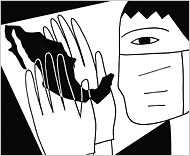
|  |  |  Editorials | Opinions | May 2009 Editorials | Opinions | May 2009  
The Smile Behind the Mask
 David Lida - New York Times David Lida - New York Times
go to original


| | (Anthony Russo) |  |
On Monday — before the World Health Organization raised its pandemic alert to its second-highest level — it was easy enough to laugh about the swine flu, however inappropriately. Mexico City has lived through floods, earthquakes, diseases, violence, pollution and crime. Its residents, known as chilangos, are very good at toughing things out, and masters at improvisation.

On the streets of the city’s historic center, nearly everyone wore a surgical mask. Some moved them to the sides of their faces while they puffed on cigarettes. Many talked through them on cell phones. Others wore them jauntily around their necks as if they were scarves. One woman had drawn a smiling mouth with a magic marker. A man had a mask completely covering his face — and wore sunglasses. He looked like Claude Rains in “The Invisible Man.”

I came down with the flu in late March. My doctor prescribed some pills that I took for 10 days, and then I felt better. When I heard about this scary strain of swine flu late last week, I panicked and returned to him. He shrugged, and calmly told me that my flu had “probably” been of the porcine variety, and warned that I could become infected again.

So on Monday I went downtown looking for an antibacterial gel to clean my hands on the street when no soap and water are available. The five or six drug stores near my apartment were sold out. But a visit to one of the giant pharmacies was not such a brilliant idea. Dozens, if not hundreds, waited in snaking lines. The pharmacies with fewer customers told me they were out of the gel — as well as of Tamiflu and Relenza, the two antiviral drugs that are supposed to treat swine flu.

With no success in the pharmacies, I did what I usually do in moments of frustration and anxiety: I went to a cantina. Many were closed, but one called El Jarrito, which could be flatteringly described as a dive, remained open. The waitresses, short and squat, encased in tight skirts and suffocating beige hose, circulated among the customers. The woman who served me a drink lowered her mask to flash me a crooked-toothed smile. Customers laughed, argued, played dominoes and lowered their masks to drink or eat.

I sipped my beer. I looked around at all the places where a disease could be hiding: the chipping paint and chunks of missing plaster; the filthy blades on the ceiling fans; a rag that looked as if it hadn’t been rinsed out in a year.

Despite reports that Mexico City had turned into a ghost town, by Thursday there were still a lot of people in the street. The hardware stores, light-fixture shops and places that sell pots and pans were all doing business. Shoeshine boys and lottery ticket vendors were out and about.

Places that sell food — from white-tablecloth restaurants to taco stands — were ordered to dispense it only for takeaway. Most of them seemed to be following orders. But there were still plenty of holes-in-the-wall that were serving people inside, and others with customers whose concept of taking food “to go” was eating it on the sidewalk in front of the restaurant. Some café owners interpreted the ban to mean that they could serve customers so long as it was only coffee, without food.

Still, the panic is mounting and it more difficult to laugh. When I am home alone, I am frightened. So to calm my nerves my last stop on Thursday was El Jarrito, in the hope that I could coax another crooked smile from the waitress. It was closed.

David Lida is the author of “First Stop in the New World: Mexico City, Capital of the 21st Century.” |

 |
|  |



